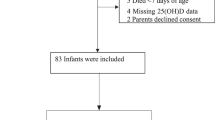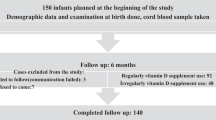Abstract
Background/Objectives:
There are other benefits of vitamin D than those for bone health. To determine the association of serum 25-hydroxy vitamin D (25(OH)D) concentrations in newborns with acute lower respiratory infection (ALRI) and without clinical signs of rickets, and their mothers. The design comprises a hospital-based case-control study.
Subjects/Methods:
The study group consisted of 25 newborns with ALRI who were admitted to neonatal intensive care unit and their mothers. Controls were 15 healthy newborns of the same age as the study group and their mothers. A commercial radioimmunoassay was used to measure 25(OH)D concentrations in serum for assessing vitamin D status.
Results:
The two groups were similar in gestational week, birth weight, birth height, head circumference, age and gender. The mean serum 25(OH)D concentrations in the study group newborns were lower than those of the control group (9.12±8.88ng/ml and 16.33±13.42 ng/ml, respectively) (P=0.011). Also, mean serum 25(OH)D concentrations in the mothers of the study group were lower than those in the mothers of the control group (13.38±16.81 ng/ml and 22.79±16.93 ng/ml respectively) (P=0.012). In 87.5% of all newborns and 67.5% of all mothers, serum 25(OH)D concentrations were lower than 20 ng/ml. The 25(OH)D concentrations of newborns were highly correlated with mothers' serum 25(OH)D concentrations.
Conclusions:
Our findings suggest that newborns with subclinical vitamin D deficiency may have an increased risk of suffering from ALRI. The strong positive correlation between newborns' and mothers' 25(OH)D concentrations shows that adequate vitamin D supplementation of mothers should be emphasized during pregnancy especially in winter months.
This is a preview of subscription content, access via your institution
Access options
Subscribe to this journal
Receive 12 print issues and online access
$259.00 per year
only $21.58 per issue
Buy this article
- Purchase on Springer Link
- Instant access to full article PDF
Prices may be subject to local taxes which are calculated during checkout
Similar content being viewed by others
References
Barnett ED, Klein JO (2006). Bacterial infections of the respiratory tract. In: Remington JS, Klein JO, Wilson CB, Baker CJ (eds). Infectious Diseases of the Fetus and Newborn Infant. WB Saunders: Philadelphia, pp 297–316.
Black PN, Scragg R (2005). Relationship between serum 25-hydroxyvitamin D and pulmonary function in the third national health and nutrition examination survey. Chest 128, 3792–3798.
Bodnar LM, Simhan HN, Powers RW, Frank MP, Cooperstein E, Roberts JM (2007). High prevalence of vitamin D insufficiency in black and white pregnant women residing in the northern United States and their neonates. J Nutr 137, 447–452.
Cannell JJ, Vieth R, Umhau JC, Holick MF, Grant WB, Madronich S et al. (2006). Epidemic influenza and vitamin D. Epidemiol Infect 134, 1129–1140.
Cantorna MT (2006). Vitamin D and its role in immunology: multiple sclerosis, and inflammatory bowel disease. Prog Biophys Mol Biol 92, 60–64.
Dawodu A, Agarwal M, Sankarankutty M, Hardy D, Kochiyil J, Badrinath P (2005). Higher prevalence of vitamin D deficiency in mothers of rachitic than nonrachitic children. J Pediatr 147, 109–111.
De Luca HF (2004). Overview of general physiologic features and functions of vitamin D. Am J Clin Nutr 80 (Suppl 6), S1689–S1696.
Gannage-Yared MH, Chemali R, Yaacoub N, Halaby G (2000). Hypovitaminosis D in a sunny country: relation to lifestyle and bone markers. J Bone Miner Res 15, 1856–1862.
Gombart AF, Borregaard N, Koeffler HP (2005). Human cathelicidin antimicrobial peptide (CAMP) gene is a direct target of the vitamin D receptor and is strongly up-regulated in myeloid cells by 1,25-dihydroxyvitamin D3. FASEB J 19, 1067–1077.
Grant WB, Garland CF, Holick MF (2005). Comparisons of estimated economic burdens due to insufficient solar ultraviolet irradiance and Vitamin D and excess solar UV irradiance for the United States. Photochem Photobiol 81, 1276–1286.
Grant WB, Holick MF (2005). Benefits and requirements of vitamin D for optimal health: a review. Altern Med Rev 10, 94–111.
Hanley DA, Davison KS (2005). Vitamin D insufficiency in North America. J Nutr 135, 332–337.
Hatun S, Ozkan B, Orbak Z, Doneray H, Cizmecioglu F, Toprak D et al. (2005). Vitamin D deficiency in early infancy. J Nutr 135, 279–282.
Holick MF (2004). Sunlight and vitamin D for bone health and prevention of autoimmune diseases, cancers, and cardiovascular disease. Am J Clin Nutr 80 (Suppl, 6), S1678–S1688.
Hollis BW (2005). Circulating 25-hydroxy vitamin D levels indicative of vitamin D sufficiency: implications for establishing a new effective dietary intake recommendation for vitamin D. J Nutr 135, 317–322.
Hollis BW, Wagner CL (2004). Vitamin D requirements during lactation: high-dose maternal supplementation as therapy to prevent hypovitaminosis D for both the mother and the nursing infant. Am J Clin Nutr 80 (Suppl, 6), S1752–S1758.
Hollis BW, Wagner CL (2006). Vitamin D deficiency during pregnancy: an ongoing epidemic. Am J Clin Nutr 84, 273.
Javaid MK, Crozier SR, Harvey NC, Gale CR, Dennison EM, Boucher BJ et al. (2006). Maternal vitamin D status during pregnancy and childhood bone mass at age 9 years: a longitudinal study. Lancet 367, 36–43.
Lee JM, Smith JR, Philipp BL, Chen TC, Mathieu J, Holick MF (2007). Vitamin D deficiency in a healthy group of mothers and newborn infants. Clin Pediatr (Phila) 46, 42–44.
Liu PT, Stenger S, Li H, Wenzel L, Tan BH, Krutzik SR et al. (2006). Toll-like receptor triggering of a vitamin D-mediated human antimicrobial response. Science 311, 1770–1773.
Monto AS, Lehmann D (1998). Acute respiratory infections in children: prospects for prevention. Vaccine 16, 1582–1588.
Muhe L, Lulseged S, Mason KE, Simoes EAF (1997). Case control study of the role of nutritional rickets in the risk of developing pneumonia in Ethiopian children. Lancet 349, 1801–1804.
Najada AS, Habashneh MS, Khader M (2004). The frequency of nutritional rickets among hospitalized infants and its relation to respiratory diseases. J Trop Pediatr 50, 364–368.
Schelonka LR, Freij BJ, McCrackhen GH (2005). Bacterial and fungal infections. In: MacDonald MH, Seshia MMK, Mullet MD (eds). Avery's Neonatology Pathophysiology & Management of the Newborn. Lippincott W&W: Philadelphia, pp 1235–1273.
Specker B (2004). Vitamin D requirements during pregnancy. Am J Clin Nutr 80 (Supp, 6), S1740–S1747.
Ustianowski A, Shaffer R, Collin S, Wilkinson RJ, Davidson RN (2005). Prevalence and associations of vitamin D deficiency in foreign-born persons with tuberculosis in London. J Infect 50, 432–437.
Valdivielso JM, Fernandez E (2006). Vitamin D receptor polymorphisms and diseases. Clin Chim Acta 371, 1–12.
Wang TT, Nestel FP, Bourdeau V, Nagai Y, Wang Q, Liao J et al. (2004). 1,25-Dihydroxyvitamin D3 is a direct inducer of antimicrobial peptide gene expression. J Immunol 173, 2909–2912.
Wayse V, Yousafzai A, Mogale K, Filteau S (2004). Association of subclinical vitamin D deficiency with severe acute lower respiratory infection in Indian children under 5 y. Eur J Clin Nutr 58, 563–567.
Webb AR (2006). Who, what, where and when—influences on cutaneous vitamin D synthesis. Prog Biophys Mol Biol 92, 17–25.
Webb AR, Kline L, Holick MF (1988). Influence of season and latitude on the cutaneous synthesis of vitamin D3: exposure to winter sunlight in Boston and Edmonton will not promote vitamin D3 synthesis in human skin. J Clin Endocrinol Metab 67, 373–378.
Weiler H, Fitzpatrick-Wong S, Veitch R, Kovacs H, Schellenberg J, McCloy U et al. (2005). Vitamin D deficiency and whole-body and femur bone mass relative to weight in healthy newborns. CMAJ 172, 757–761.
World Health Report 2005: http://www.who.int/whr/2005/annex/en/index.html.
Author information
Authors and Affiliations
Corresponding author
Additional information
Note: Accepted for presentation in poster form at the XV Congress of Balkan Clinical Laboratories Federation, September 4–7, 2007 Antalya, Turkey.
Rights and permissions
About this article
Cite this article
Karatekin, G., Kaya, A., Salihoğlu, Ö. et al. Association of subclinical vitamin D deficiency in newborns with acute lower respiratory infection and their mothers. Eur J Clin Nutr 63, 473–477 (2009). https://doi.org/10.1038/sj.ejcn.1602960
Received:
Revised:
Accepted:
Published:
Issue Date:
DOI: https://doi.org/10.1038/sj.ejcn.1602960
Keywords
This article is cited by
-
Vitamin D - An Elixir for Recurrent Upper Respiratory Tract Infection
Indian Journal of Otolaryngology and Head & Neck Surgery (2023)
-
Synergy of melanin and vitamin-D may play a fundamental role in preventing SARS-CoV-2 infections and halt COVID-19 by inactivating furin protease
Translational Medicine Communications (2020)
-
Was ist bekannt über den Vitamin-D-Status und seine Auswirkungen im professionellen Bühnentanz?
Zentralblatt für Arbeitsmedizin, Arbeitsschutz und Ergonomie (2020)
-
Is Lower Vitamin D Level Associated with Increased Risk of Neonatal Sepsis? A Prospective Cohort Study
The Indian Journal of Pediatrics (2020)
-
Effect of Vitamin D Supplementation in the Prevention of Recurrent Pneumonia in Under-Five Children
The Indian Journal of Pediatrics (2019)



